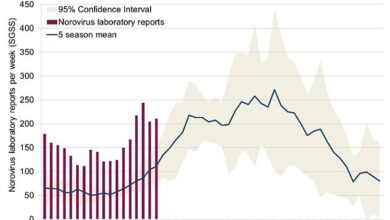I tried the new DIY smear test – it was so simple, I did mine in the office loo during my morning coffee break… says MailOnline Health Editor EVE SIMMONS










DIY home smear tests could soon be sent out to millions of women every year in a bid to boost cervical cancer screening uptake and save lives.
Having tried it myself — I was one of 27,000 British women who used it as part of a trial which has just been published— I think it’s a brilliant idea.
It could not have been quicker or simpler. In fact, I did mine in around two minutes, in the office loo, during my morning coffee break.
And like the experts running the trial, I am convinced if all women had the option, it would increase numbers taking these tests — something that’s absolutely needed.
Currently in the UK, women aged 25 to 49 are invited for cervical screening at their GP surgery every three years. Those aged 50 to 64 can have one every five years.

MailOnline’s health editor Eve Simmons, pictured, tested out a new NHS cervical cancer screening test which can be done at home or in the office

Currently, women aged 25 to 49 are invited for a cervical screening test at their local GP surgery once every three years, or every five years for those aged 49 to 64

The self-testing kits like this one (pictured) are expected to ‘revolutionise’ cervical cancer diagnosis
The traditional method involves lying, naked from the waist down, with your legs up as a nurse inserts a tube-shaped instrument called a speculum into the vagina.
This allows them to see the cervix — the opening to the uterus — and take a sample of cells from it, which are then tested the human papillomavirus virus, or HPV, which causes 99 per cent of cervical cancers.
I don’t mind it, personally. It’s vaguely uncomfortable but not a problem. However, I have friends who find it painful.
But more importantly, screening uptake overall isn’t great only about 70 per cent of eligible women, roughly 4.6million, turn up for their scheduled test.
Embarrassment is a factor, according to research by cervical cancer charities. This can be particularly as issue for women from certain cultural backgrounds.
But for half of the 1.3 million no-shows every year, getting time off work and finding a convenient time to fit in an appointment are the reasons they miss it.
The new DIY approach will effectively tackle all these issues at once.
During the latest trial, scientists at King’s College London, in partnership with NHS England, sent kits to thousands of women in London.
I volunteered to try the test, to see if it’s as easy as they reckon it is.

NHS cervical screening data, which goes back to 2011, shows uptake was at its highest that year (75.7 per cent) but has fallen over time
And, I must admit, I did a little shudder when I decided to take on this assignment.
Like most girls, at school we were instructed to do ‘the mirror test’ – where you sit on the floor with your legs bent, hold a mirror out in front of you and familiarise yourself with your own anatomy.
The exercise is designed to help you spot unusual changes. But I didn’t do it.
Let’s just say, it’s not an activity I’ve ever felt compelled to dedicate time to. And I did feel apprehensive, not least at the prospect of having to ‘dig around’ for a sample.
But I had no reason to worry — for a start, there’s no speculum involved.
The kit comes in a little box and consists of a swab — a long stick with a cotton bud on the end of it — housed in its own little plastic screw-up test tube-type-thing.
I took this, along with the instructions — which looks like something that might be handed out in a sixth-form sex-education class — off to the toilet.
The first picture in the how-to guide shows a woman – oddly, naked – with one leg in the air.
In the second she’s sitting on the toilet (still naked), peering between her legs. I decided it was easier to do standing up, with my trousers round my ankles.
You take the swab and push it into the vagina, about as far as you would to insert a tampon, twist it around for 20 seconds, pull it out, put it in a test tube pot and pop that in the post to go off for analysis.

Many younger women, in particular, are not responding to invitations, due to fears over the test causing pain or embarrassment
There’s no pain or discomfort, just 20 seconds of ever-so-slight scratchiness — again, similar to removing a tampon.
The method is so idiot-proof that, according to studies, less than 1 per cent of women fail to do it correctly. You barely need to refer to the instructions.
The suggested positions, I found, were unnecessary.
The innovation has been made possible by a change in the type of test used in cervical screening.
Dr Anita Lim, lead researcher on the study at King’s College London, told me: ‘Traditionally, smear tests have involved taking samples of cells specifically from the cervix, which are then examined.
‘And the person doing the smear test needs a speculum to move other bits of the anatomy out the way, to find it.’

Cervical cancer symptoms to look out for include unusual vaginal bleeding, pain during sex and lower back or pelvic pain

Since 2019, doctors have been targeting women who have failed to show up for their traditional smear test – which takes cell samples from the cervix – for the swab test which searches for the HPV virus in the vaginal canal
But since 2019, doctors have moved towards first testing for HPV.
The virus is transmitted during sexual activity and is basically endemic. Up to eight in ten of the population, both men and women, are thought to be carrying it at any given moment.
Most of the time, it’s totally harmless. But a handful of the 150 strains can, in some cases, invade the genital tract where it causes cells to mutate and turn cancerous.
The virus can be found throughout the vaginal canal, so taking a sample is easy.
If a smear comes back positive for high-risk HPV, further tests are carried out to flag up if there really is a cancer risk and whether treatment is needed.
Around the same time the London trail was launched, the results of Scottish trials showed that DIY tests — also known as self-sampling — were as accurate as the in-clinic test.
And, like me, medics welcome the proposed rollout.

Thousands of women are diagnosed with cervical cancer every year, leading to 685 deaths in England annually. Only around half of women (51 per cent) survive 10 years or more after diagnosis. Diagnoses are most common among women in their thirties
As Dr Adeola Olaitan, a consultant gynaecologist at University College London Hospitals NHS Foundation Trust, said: ‘For years, campaigners have been asking why don’t we just let women swab themselves.
‘They’ve done it for years in other countries such as Denmark and Australia. Covid sort of revved everything up a gear.’
‘This is the future of women’s healthcare – more choice, more freedom,’ says Dr Lim. ‘It removes the invasiveness and embarrassment and, instead, empowers women to protect their own health.
‘There’s plenty of robust evidence to show this works, so it was only a matter of time before it became available to NHS patients.’
The at-home tests may initially only be offered to those who don’t show up to their smear appointments.
With the DIY test women will miss out on the visual examination that happens at the GP surgery.
Looking at the cervix is useful for spotting other abnormalities that may remain undetected, such as infections or non-cancerous growths called polyps.
But these so-called incidental findings are spotted in only 7 per cent of appointments, according to studies.
It’s also important to note, that a positive HPV test result doesn’t mean have or are going to get cancer.
‘HPV is very common in women under 25, and it’s extremely rare for it to develop into cervical cancer,’ says Dr Jo Waller, an expert in cervical cancer prevention at King’s College London.
‘In young women, HPV usually goes away on its own and causes no problems. Some people liken it to a cold for the genitals.
‘More often than not, the immune system clears it up and you’d never know you’d had it.’
Roughly 20 in every 100 women have what’s known as a tilted uterus – where the uterus hinges slightly backwards where it meets the cervix, rather than forwards.
In these cases, having a speculum inserted can be very painful. But experts say these patients will benefit from the DIY test, too.
‘The beauty of this test is it doesn’t force women into an uncomfortable position,’ says Dr Olaitan.
‘You don’t have to see the cervix to get the sample. And there’s no lying down on a bed — you can do it in whichever position is easiest.

During the latest trial, scientists at King’s College London, in partnership with NHS England, sent kits to thousands of women in London
‘Basically, anyone who can insert a tampon can take their own swab.’
If successful, health chiefs want to roll a programme out nationwide – a move that could drastically boost the 5,000 lives a year it saves at the moment.
A few days after my self-test, the result came through.
In truth, I already knew what it’d say, as I’d had a normal smear test two weeks previously: Negative – hurrah.
Still, I appreciated the reassurance. And all it took was a two-minute trip to the toilet.




